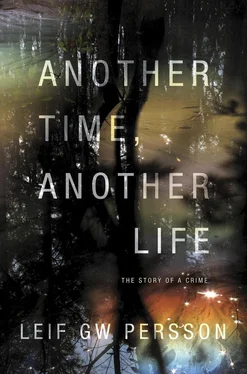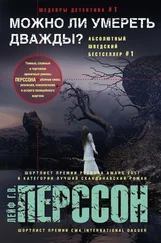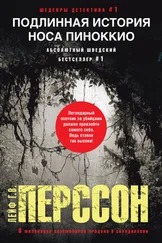The very next day another application arrived. A number of political youth organizations, representing with one exception all of the parties in parliament, wanted to conduct “a broad, popular manifestation against xenophobia and racism.” So far so good. But for reasons that were not completely clear, in any case not evident from their request, the intention was to conduct this demonstration on that very same Thursday, the thirtieth of November, between 1900 and 2200 hours. There would be a gathering in Humlegården, a march down Birger Jarlsgatan and up Hamngatan, concluding “with speeches and a joint proclamation” at Sergels Torg, all of 400 yards from the statue of Charles XII in Kungsträdgården.
As far as political opinions were concerned, the participants in the two demonstrations were, to put it mildly, dissimilar, to the point where they could easily be sorted into two different piles based solely on their appearance. And this nonexistent common interest would evidently be expressed at the same time and the same place. The sharp minds in the legal department were struck by this. In brief, trickery was suspected, and in order to prevent difficulties, the good old police rule of thumb was followed to separate even presumptive troublemakers.
This plan primarily affected the group of the “patriotically minded.” There was no question of playing political favorites — of course, no official authority could support such things. The decision was made solely on the basis of police department estimates of the relative size of the two groups. Democratic decisions were after all in many respects made based on a question of size, and the friends of the fatherland were considerably fewer in number. As the chief inspector on the detective squad in charge of estimates summarized the matter, it concerned at the most a few hundred, “a few old queers from the Finnish Winter War plus their younger, skinhead comrades,” which was not “very much to hang on the Christmas tree if it’s democracy we’re talking about here.”
So true, so true. And in a time of severely strained police resources the patriotically minded demonstrators were thus granted permission to gather at the pier below the Grand Hotel at 1800 hours, walk in formation about a hundred yards to the statue of Charles XII, where of course it was fine both to lay wreaths and to give speeches, provided that the event was over at 1900 hours at the latest and that the crowd then “dispersed in good order.” They could even sing the national anthem if they wanted to, despite the fact that, probably due to a simple omission, this activity had not been included in the application.
On the other hand, they could forget about the torches. “You don’t really think we’re dim-witted,” as the same chief inspector remarked in explaining the rejection when one of the organizers phoned him to discuss that particular detail. And as far as flag-waving was concerned, it was assumed that this would be kept within reasonable bounds.
On the other hand, because the participants in “the broad popular manifestation,” exactly as promised and according to a similar police department calculation, could be assumed to amount to several thousand, based on the same democratic principles the authorities had been considerably more generous. On the condition that the gathering really commenced at 1900 hours, and in no event earlier, it was fine for the demonstration to set off from Humlegården. And the demonstration could end at Sergels Torg if the crowd took Kungsgatan and Sveavägen instead of Birger Jarlsgatan and Hamngatan.
All available police personnel were then called up, and to be on the safe side they were reinforced with a few hundred men from around the country. An “iron ring” was formed around Kungsträdgården, and the route of the counterdemonstrators was secured yard by yard and well supplied with mobile reserves behind the front lines. Literally everything was being done, it was being done by the book and in the best way, and already by eight p.m. complete chaos prevailed in Stockholm City: rock throwing, window breaking, battered cars... swollen lips, bloody noses, black eyes, broken arms, scraped knees, even a knife cut. There were howling sirens, flashing blue lights, yet at the command center they managed to keep a straight face when in the midst of it all an elderly woman phones and maintains that someone is murdering her neighbor.
Between 2005 and 2020 hours, she calls the emergency number 90 000 a total of three times. She is quickly transferred to the police command center. Already during the first call she sounds very upset but nonetheless she starts by saying in good order what her name is and where she lives: “Rådmansgatan... up by Engelbrekt Church, you know.” After that she says, verbatim, according to the police department’s time-logged recording of the conversation, “You’ve got to come at once. Someone is murdering my neighbor. I think he’s dying.”
The female radio dispatcher tries to calm her as best she can and asks her to stay on the phone while she dispatches the alarm on the radio, but while she tries to find someone to send out, the call is cut off. Probably because the woman who called hung up.
The next call comes at 2014 hours, and the old woman’s voice sounds close to tears. “You’ve got to come. You’ve got to come,” and in the midst of the general muddle that prevails this call too is cut off and no available patrol car has yet been reached.
The third and final call comes at 2020. Now the woman is screaming loudly into the telephone that “the murderers are knocking on my door,” and this is the situation when detective inspector Bo Jarnebring has mercy on his colleague, the radio dispatcher, who has started to sound more and more stressed, takes the microphone out of its holder on the instrument panel, breaks his radio silence, and responds to the call from central command.
Inspector Bo Jarnebring was a few miles from the center of events. At eight p.m. on Thursday the thirtieth of November, he had been sitting for a couple of hours along with a female colleague in one of the detective squad’s most discreet cars, keeping an eye on a restaurant fifty yards farther down the street. The first hour they had been accompanied by an additional surveillance vehicle, but then the growing chaos down in City had forced the officers to respond to more pressing assignments instead.
Jarnebring and his partner were sitting there because of a tip that had come in the day before. This was, incidentally, the most common reason for anyone’s spending time in this way, and if any one of the growing number of bureaucrats in police headquarters ever got the notion to produce statistics on this activity as well, then he (for it was almost always a he) or (in exceptional cases) she would have discovered that as a rule the sitting was in vain. It was exactly like hunting or fishing, uncertainty and waiting were basically the whole idea, and whether or not you got anything it was, at least to start with, exciting enough.
The catch that their informant had promised this time wasn’t bad either. According to the informant, who in the name of discretion lacked all identifying features but in reality was almost always a man with a criminal record, an internationally wanted Iranian drug dealer at the wholesale level would show up around six p.m. to have dinner and discuss a little business with a like-minded countryman.
Jarnebring, who had neither been born yesterday nor recently fallen off a cart, had of course asked the informant why in such a case the Iranians would choose to hold this get-together at a restaurant that with good reason was known for its Swedish home cooking, but the informant had an answer: “Saddam is an ace at not giving himself away, likes sort of exotic settings you know, and besides he’s crazy about Swedish meatballs.”
Читать дальше












